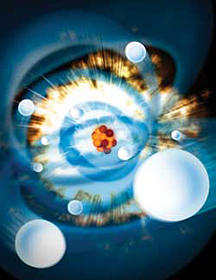Home > Press > Unpeeling atoms and molecules from the inside out
 |
| First experiments at SLAC's Linac Coherent Light Source stripped electrons one by one from neon atoms. Credit: Gregory Stewart, SLAC. |
Abstract:
The first published scientific results from the world's most powerful hard X-ray laser, located at DOE's SLAC National Accelerator Laboratory, show its unique ability to control the behaviors of individual electrons within simple atoms and molecules by stripping them away, one by one—in some cases creating hollow atoms.
Unpeeling atoms and molecules from the inside out
Menlo Park, CA | Posted on July 19th, 2010These early results describe in great detail how the Linac Coherent Light Source's intense pulses of X-ray light change the very atoms and molecules they are designed to image. Controlling those changes will be critical to achieving the atomic-scale images of biological molecules and movies of chemical processes that the LCLS is designed to produce.
In a report published in the July 1 issue of Nature, a team led by Argonne National Laboratory physicist Linda Young describes how they were able to tune LCLS pulses to selectively strip electrons, one by one, from atoms of neon gas. By varying the photon energies of the pulses, they could do it from the outside in or—a more difficult task—from the inside out, creating so-called "hollow atoms."
"Until very recently, few believed that a free-electron X-ray laser was even possible in principle, let alone capable of being used with this precision," said William Brinkman, director of DOE's Office of Science. "That's what makes these results so exciting."
In another report, published June 22 in Physical Review Letters, a team led by physicist Nora Berrah of Western Michigan University—the third group to conduct experiments at the LCLS—describes the first experiments on molecules. Her group also created hollow atoms, in this case within molecules of nitrogen gas, and found surprising differences in the way short and long laser pulses of exactly the same energies stripped and damaged the nitrogen molecules.
"We just introduced molecules into the chamber and looked at what was coming out there, and we found surprising new science," said Matthias Hoener, a postdoctoral researcher in Berrah's group at WMU and visiting scientist at Lawrence Berkeley National Laboratory who was first author of the paper. "Now we know that by reducing the pulse length, the interaction with the molecule becomes less violent."
While the first experiments were designed to see what the LCLS can do and how its ultra-fast, ultra-bright pulses interact with atoms and molecules, they also pave the way for more complex experiments to come. Its unique capabilities make the LCLS a powerful tool for research in a wide range of fields, including physics, chemistry, biology, materials and energy sciences.
More here home.slac.stanford.edu/pressreleases/2010/20100630.htm
####
For more information, please click here
Contacts:
Glennda Chui
650-926-4897
Copyright © DOE Pulse
If you have a comment, please Contact us.Issuers of news releases, not 7th Wave, Inc. or Nanotechnology Now, are solely responsible for the accuracy of the content.
| Related News Press |
News and information
![]() Researchers develop molecular qubits that communicate at telecom frequencies October 3rd, 2025
Researchers develop molecular qubits that communicate at telecom frequencies October 3rd, 2025
![]() Next-generation quantum communication October 3rd, 2025
Next-generation quantum communication October 3rd, 2025
![]() "Nanoreactor" cage uses visible light for catalytic and ultra-selective cross-cycloadditions October 3rd, 2025
"Nanoreactor" cage uses visible light for catalytic and ultra-selective cross-cycloadditions October 3rd, 2025
Possible Futures
![]() Spinel-type sulfide semiconductors to operate the next-generation LEDs and solar cells For solar-cell absorbers and green-LED source October 3rd, 2025
Spinel-type sulfide semiconductors to operate the next-generation LEDs and solar cells For solar-cell absorbers and green-LED source October 3rd, 2025
Academic/Education
![]() Rice University launches Rice Synthetic Biology Institute to improve lives January 12th, 2024
Rice University launches Rice Synthetic Biology Institute to improve lives January 12th, 2024
![]() Multi-institution, $4.6 million NSF grant to fund nanotechnology training September 9th, 2022
Multi-institution, $4.6 million NSF grant to fund nanotechnology training September 9th, 2022
Announcements
![]() Rice membrane extracts lithium from brines with greater speed, less waste October 3rd, 2025
Rice membrane extracts lithium from brines with greater speed, less waste October 3rd, 2025
![]() Researchers develop molecular qubits that communicate at telecom frequencies October 3rd, 2025
Researchers develop molecular qubits that communicate at telecom frequencies October 3rd, 2025
![]() Next-generation quantum communication October 3rd, 2025
Next-generation quantum communication October 3rd, 2025
![]() "Nanoreactor" cage uses visible light for catalytic and ultra-selective cross-cycloadditions October 3rd, 2025
"Nanoreactor" cage uses visible light for catalytic and ultra-selective cross-cycloadditions October 3rd, 2025
Tools
![]() Japan launches fully domestically produced quantum computer: Expo visitors to experience quantum computing firsthand August 8th, 2025
Japan launches fully domestically produced quantum computer: Expo visitors to experience quantum computing firsthand August 8th, 2025
![]() Rice researchers harness gravity to create low-cost device for rapid cell analysis February 28th, 2025
Rice researchers harness gravity to create low-cost device for rapid cell analysis February 28th, 2025
Research partnerships
![]() Lab to industry: InSe wafer-scale breakthrough for future electronics August 8th, 2025
Lab to industry: InSe wafer-scale breakthrough for future electronics August 8th, 2025
![]() HKU physicists uncover hidden order in the quantum world through deconfined quantum critical points April 25th, 2025
HKU physicists uncover hidden order in the quantum world through deconfined quantum critical points April 25th, 2025
|
|
||
|
|
||
| The latest news from around the world, FREE | ||
|
|
||
|
|
||
| Premium Products | ||
|
|
||
|
Only the news you want to read!
Learn More |
||
|
|
||
|
Full-service, expert consulting
Learn More |
||
|
|
||








